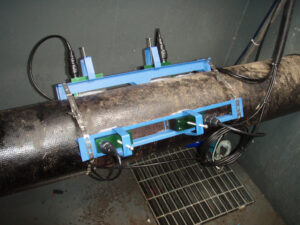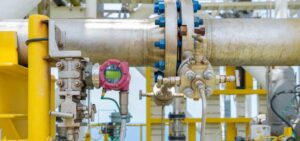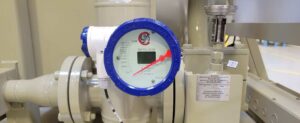Liquid flow meters are devices used to measure the volumetric or mass flow rate of liquids. They have a wide range of applications across many industries including water treatment, food and beverage, pharmaceuticals, chemicals, oil and gas, and more. This article provides a detailed overview of the different types of liquid flow meters, their working principles, applications, advantages and limitations.
What is a Liquid Flow Meter?
A liquid flow meter is an instrument used to measure the volumetric flow rate of a liquid flowing through a closed conduit. It works by sensing the flow using different techniques, displaying the measured flow rate and total accumulated flow in an integral or remote-mounted display, and generating an output signal that is proportional to the flow rate. The flow rate data is essential for monitoring, controlling and optimizing processes that involve liquid flow.
Some key terms related to liquid flow meters:
- Flow rate – Volume of liquid passing per unit time, measured in units like liters/second, gallons/minute, etc.
- Accuracy – How close the measured flow rate is to the actual value. Higher accuracy meters have lower errors.
- Repeatability – Ability of the meter to provide consistent results every time the same flow rate is measured.
- Turndown ratio – The ratio between the maximum and minimum flow rates that can be measured by a flow meter. A high turndown ratio allows greater flow measurement rangeability.
Types of Liquid Flow Meters
There are several different technologies and working principles used in liquid flow meters. The most common types are:
1. Differential Pressure Flow Meters
These meters work by measuring the pressure difference across a primary device like an orifice plate, Venturi tube, flow nozzle or pitot tube placed in the flow. The primary device creates a constriction that produces a pressure drop proportional to the flow rate. This differential pressure is sensed by the instrument.
Advantages: Simple, low cost, high turndown ratio, suitable for dirty liquids
Applications: Water, chemicals, oil
2. Positive Displacement Flow Meters
These meters contain moving components that repeatedly fill and displace a known volume of liquid. Counting the number of fill/displace cycles per unit time determines the flow rate.
Types:
- Nutating disc
- Oval gear
- Rotary piston
- Diaphragm
Advantages: High accuracy, suitable for high viscosity liquids
Applications: Flow calibration, custody transfer, food and beverage
3. Velocity Flow Meters
These meters have sensors that measure the liquid’s velocity. The velocity is then converted into a flow rate using the pipe cross-section area.
Types:
- Turbine
- Electromagnetic
- Ultrasonic
- Vortex
Advantages: No pressure loss, high rangeability
Applications: Water, chemicals, hydrocarbons
4. Mass Flow Meters
These meters directly measure the mass flow rate instead of volumetric flow rate. They work by sensing the force produced by the flowing liquid with a sensor inserted in the flow.
Types:
- Coriolis
- Thermal
Advantages: Measure mass flow directly, high accuracy
Applications: Custody transfer, filling applications
5. Variable Area Flow Meters
These simple meters have a tapered tube and float/piston assembly. Liquid flow raises the float, with its height indicating flow rate on a scale.
Advantages: Simple, low cost, transparent operation
Applications: Low flow measurement, flow control
Key Considerations for Selecting a Liquid Flow Meter
To choose the optimal flow meter for an application, the following parameters must be considered:
- Liquid properties – density, viscosity, temperature, conductivity, impurities
- Pipe size
- Flow rate range – minimum and maximum
- Operating pressure and temperature
- Accuracy required
- Straight inlet/outlet piping requirements
- Installation constraints – weight, space
- Cost
Additionally, the meter must be compatible with the liquid. Factors like corrosion resistance, materials of construction and pressure drop must be accounted for.
Applications of Liquid Flow Meters
Liquid flow meters are ubiquitous across industries like:
- Water & Wastewater – Flow monitoring at treatment plants, distribution network leakage monitoring
- Food & Beverage – Flow measurement and control for bottling/canning lines, batching, filling machines
- Pharmaceutical – Accurate additive and raw material batching, filling machines
- Oil & Gas – Custody transfer, allocation measurement, leak monitoring, production optimization
- Chemical & Petrochemical – Reactant flow control, plant efficiency improvement, end-product filling
- Power – Feedwater flow monitoring, condenser water flow
- Pulp & Paper – Flow measurement for materials, chemicals, ingredients and additives
- Metal & Mining – Slurry transport flow monitoring, chemical additive control
Final Words
Accurate liquid flow measurement is critical across many different industries and applications. Various types of flow meters based on different working principles are available to measure flow rate, velocity, and even mass flow.
The choice of flow meter depends on the liquid properties, pipe size, flow rates, pressure and temperatures as well as the desired accuracy. Each technology has its own advantages and limitations that must be analyzed before selecting the optimal flow meter for an application. Proper installation and maintenance are also key to sustaining flow meter performance.





